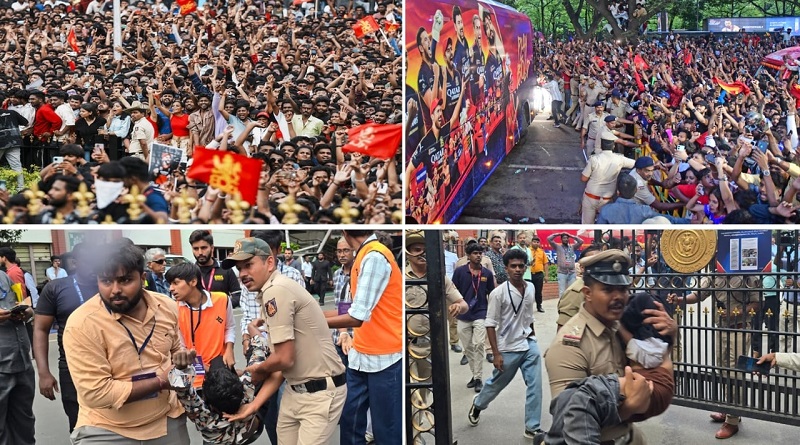Celebration Turns to Chaos: 11 Dead, 33 Injured in RCB’s Bengaluru Parade Stampede

RCB’s Victory Celebration Turns Tragic: 11 Dead, 33 Injured in Bengaluru Stampede
On June 4, 2025, the Royal Challengers Bengaluru (RCB) celebrated their maiden Indian Premier League (IPL) title with a victory parade in Bengaluru. However, the event took a tragic turn when a massive crowd gathered outside the M. Chinnaswamy Stadium, leading to a stampede that resulted in 11 fatalities and over 33 injuries.
Background
RCB clinched their first IPL title on June 3, 2025, by defeating the Punjab Kings by six runs in the final held at the Narendra Modi Stadium in Ahmedabad. To commemorate this historic win, a victory parade was organized in Bengaluru on June 4, starting from Vidhana Soudha and culminating at the M. Chinnaswamy Stadium.
Cause of the Stampede
The tragic stampede during the Royal Challengers Bengaluru (RCB) victory parade on June 4, 2025, was the result of multiple factors converging to create a catastrophic situation.
An estimated 200,000 to 300,000 fans gathered near the M. Chinnaswamy Stadium to celebrate RCB’s maiden IPL title win, far exceeding the stadium’s capacity of 35,000. Many attendees, some without valid passes, attempted to force entry through Gate 7, leading to severe overcrowding and chaos. The situation escalated rapidly, resulting in a deadly stampede that claimed 11 lives and injured over 50 individuals.
Eyewitness accounts describe the scene as one of panic and confusion. As the crowd surged forward, individuals were pushed and trampled, with some victims, including young students, suffocating in the crush. The lack of adequate crowd control measures and insufficient police presence exacerbated the situation. Despite deploying 5,000 police officers, authorities were overwhelmed by the sheer number of attendees.
The tragedy has sparked widespread criticism of the event’s planning and safety protocols. Opposition parties have accused the Congress-led Karnataka government of negligence and demanded a judicial inquiry into the incident. In response, the state government has announced compensation for the victims’ families and pledged to cover medical expenses for the injured.
This incident underscores the critical importance of meticulous planning and crowd management in large public gatherings. It serves as a somber reminder that without proper safety measures, celebrations can quickly turn into tragedies.
Administrative Response
Karnataka Chief Minister Siddaramaiah expressed deep sorrow over the incident and announced a compensation of ₹10 lakh for the families of the deceased. Additionally, the state government pledged to cover all medical expenses for the injured. RCB also launched the “RCB Cares” fund to support the victims and their families.
Political Repercussions
The stampede sparked political controversy, with opposition parties criticizing the Congress-led state government for inadequate planning and crowd management. Calls for a judicial inquiry into the incident were made, highlighting the need for accountability and better safety measures in future public events.
Reactions from the Cricketing Community
RCB’s former captain Virat Kohli expressed profound grief over the tragedy, stating he was “absolutely gutted.” Other cricketing legends, including Sachin Tendulkar, Harbhajan Singh, and Aakash Chopra, also conveyed their condolences, emphasizing the heartbreaking nature of the incident.
Social Media and Public Outcry
The incident led to widespread outrage on social media platforms. Many users criticized the event organizers and authorities for poor crowd control and safety measures. Some also questioned the decision to proceed with the celebration despite the overwhelming crowd and potential risks.
Conclusion
The tragic stampede during RCB’s IPL 2025 victory celebration in Bengaluru serves as a stark reminder of the critical importance of meticulous planning and crowd management in large public gatherings. The incident, which resulted in 11 fatalities and over 50 injuries, underscores the dire consequences of inadequate safety measures and poor coordination among event organizers and authorities. Despite prior warnings about potential risks, the organizers failed to implement effective crowd control strategies, leading to chaos and loss of life .
Moving forward, it is imperative for event planners and government agencies to prioritize public safety by establishing stringent protocols, ensuring clear communication, and conducting thorough risk assessments for large-scale events. The Bengaluru tragedy should catalyze systemic reforms in event management practices to prevent such disasters in the future.





